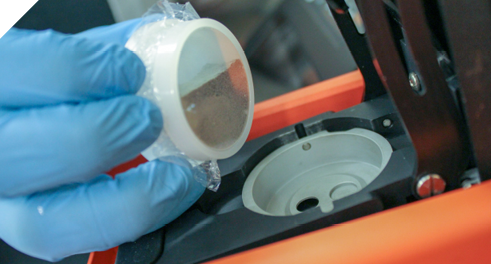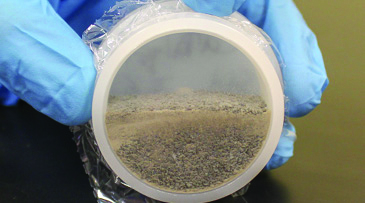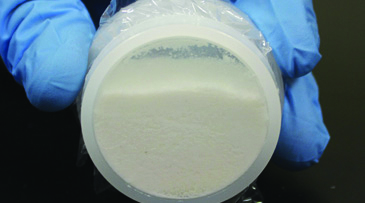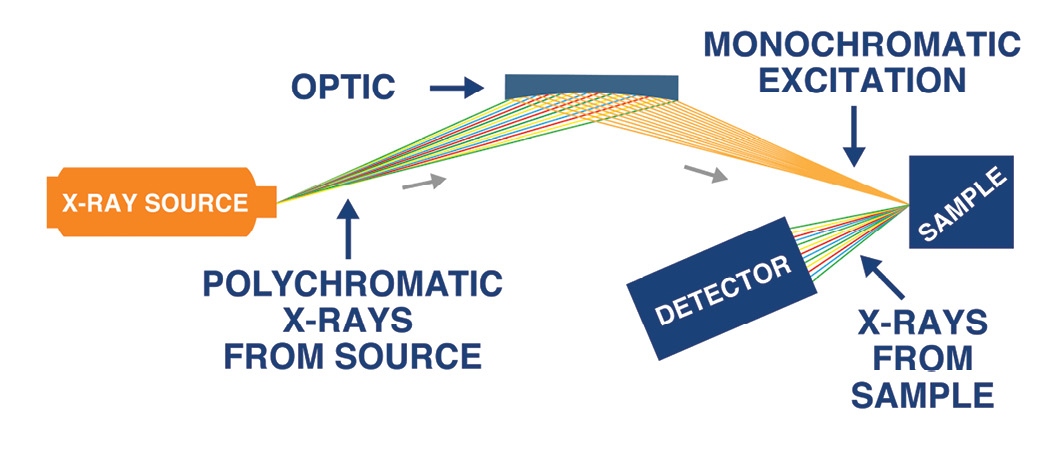- Analyzers
- Optics & Sources
- Technologies
- Support
- About
A Reliable Solution to Measure Chlorine in Catalyst by UOP 979
BACKGROUND
Over the years, refineries have fine-tuned their production methods to maximize efficiency while ensuring a higher-quality product. One such example is an increase in the use of catalysts which speed up reactions as crude oils work their way toward becoming finished products. As the use of catalysts became more commonplace, refineries quickly realized that these reaction-inducing substances were rapidly deactivating due to the naturally occurring metals commonly found in crude oil, decreasing the efficiency of their operations. To mitigate this and save time and money, refinery labs are assessing the content of these metals in crude oil to ensure that catalyst fouling is kept to a minimum. However, another important aspect of assessing catalyst efficiency requires a closer look at another element: chlorine.
CHALLENGE
In addition to keeping catalyst fouling under control, refiners are also challenged with determining catalyst lifespan. Chlorine content, depending on its level and the type of feed in question, will impact the effectiveness of the catalyst, and thus, the refining process. Therefore, one can determine how long their catalysts can be used before becoming spent or needing regeneration by monitoring chlorine concentration over time. Essentially, refiners can optimize their catalyst quality by measuring metals in crude, and then assess the payoff of those optimizations in real-time by measuring chlorine concentration trends in the catalysts themselves
SOLUTION
UOP 979 is a well-accepted test method for determining the total chloride content of fresh, regenerated, and spent alumina-supported catalysts by wavelength dispersive X-ray fluorescence (WDXRF) spectroscopy. UOP 979 also includes energy dispersive XRF (EDXRF) spectroscopy, provided the EDXRF instrument meets the precision criteria (as stated in Note 3 of the method). Petra MAX is powered by monochromatic EDXRF (HDXRF ®) and meets the precision requirements for UOP 979, and is therefore a viable solution for determining chloride content in alumina-supported catalysts.
"UOP 979 - NOTE 3: Energy Dispersive Equipment (ED-XRF) has undergone many recent technological improvements. ED-XRF may be a suitable alternative technique. However, as instruments vary widely, the user must ensure that the ED-XRF instrument meets the precision criteria stated in this method. In case of dispute, UOP Method 291, from which the calibration is derived, shall be the referee.”
In this paper, we will demonstrate that Petra MAX meets the repeatability and site precision criteria of UOP 979 based on real-world data.
Petra MAX also complies with another widelyused EPA test method – Determination of Metal Concentration on Catalyst Particles (Instrumental Analyzer Procedure) (40 CFR Part 63 Subpart UUU Appendix A). Many XOS customers are currently utilizing this EPA test method with the Petra MAX using UOP 979 calibration standards. Table 1 shows data on a 1.00% chlorine in catalyst CRM demonstrating the accuracy of two Petra MAX analyzers measuring the CRM twice in two days. Samples were prepared per the recommendations in the Sample Preparation section of this paper. As the data demonstrates, the analyzer accuracy error for all measurements is <10%, as required by the EPA method.
| Table 1 – 1.00 wt% Chlorine in Catalyst Certified Reference Material (CRM) | ||||
|---|---|---|---|---|
| Analyzer 1 Chlorine (wt%) | Analyzer 1 Accuracy Error (<10%) | Analyzer 2 Chlorine (wt%) | Analyzer 2 Accuracy Error (<10%) | |
| Day 1 Results | 0.9571 | 4% | 0.9843 | 2% |
| 0.9436 | 6% | 0.9721 | 3% | |
| Day 2 Results | 0.9770 | 2% | 0.9831 | 2% |
| 0.9562 | 4% | 0.9769 | 2% | |
SAMPLE PREPARATION
XRF analyzers function best when analyzing homogeneous samples, as the measurement results come from a relatively small focal point on the sample. For finished liquid hydrocarbon fuels, such as diesel or gasoline, this is generally not an issue as they tend to be homogeneous. Unfortunately, catalyst tends to be inherently non-homogeneous, which is why it is necessary to grind the sample to a fine powder and mix as best as possible before analysis. For best results, use a laboratory grinder to grind catalyst samples to 325 mesh. XOS also recommends tapping the ground catalyst in the sample cup prior to analysis, as this helps to compress the powder which minimizes air gaps between particles and makes a more homogeneous sample at the analyzer focal point.

Petra analyzers utilize a vertical sample introduction, which is beneficial as it directs sample spills away from critical components such as the detector and towards a drip tray instead. This design also allows for better compaction of the sample without bowing the film. For best results, it is recommended that the sample cup is almost completely filled prior to applying the film. This will result in the cup being at least 50% full in the vertical position after tapping so that the compacted powdered sample is within the analyzer focal point (which is about ⅓ of the way up from the bottom edge of the sample basket, as indicated by the hole in the sample basket in the picture to the left). Lastly, when using a Petra MAX Autosampler, it is recommended to run only one catalyst sample at a time using a vent clip so that the ground, packed sample remains in the correct orientation and packed tightly throughout the analysis.


On the left is a coarsely ground sample, and on the right is a finely ground sample. Tapping removes air gaps, but using a laboratory grinder to grind samples to 325 mesh in conjunction with tapping will produce a more homogeneous sample.
However, even grinding and thoroughly mixing the sample followed by tapping the sample cup may not be enough to ensure consistent results if the chlorine is still not homogeneously distributed in the sample. For this reason, XOS also recommends repeat analysis of the sample with multiple focal points using the following procedure:
- Prepare a catalyst sample using the best practices described above. Tap the filled sample cup on its side to compress the powder, then introduce into Petra MAX in the correct orientation (using a vent clip for autosampler analysis). Measure for 100s.
- Prepare a second sample following the same process as above, or, using the first sample, shake to mix the powder then re-tap the sample as before. Insert into Petra MAX and measure for 100s
- Prepare a third sample or reanalyze the first sample again using the procedure above.
- Report the average of the three determinations as the measurement result. This will ensure that the user gets a more accurate value, that is, a value that is more consistent with the true value of the entire sample.
EXPERIMENT
Four catalyst samples—two spent samples and two regenerated samples—were prepared and analyzed on two Petra MAX instruments at one location by one operator. Each of the samples were measured twice on each analyzer for two consecutive days. Note that per XOS best practices, a single test measurement result is the average of three 100s determinations. Between each determination, the sample cup was removed from the analyzer, shaken, and re-tapped before measuring for a second and third 100s determination. Before we look at the results, let’s review UOP 979 method precision.
The precision of the UOP test method was developed by a multi-analyzer study run on a spent, a regenerated, and a fresh catalyst sample. (Note: A fresh sample was not available for the Petra experiment and so further discussion is limited to spent and regenerated catalyst samples.) The precision is presented in the method as a series of allowable differences based on the wattage of the WDXRF analyzer and sample type. These differences are summarized in Table 2.
To comply with the precision of UOP 979, the difference between sample measurements must be less than or equal to the maximum allowable difference. Note that the lowest allowable difference is not a minimum specification. Instead, it is the lowest allowable difference reported in the method precision study. Therefore, differences between sample measurements that are lower than this lowest allowable difference indicate precision that is better than the UOP 979 method.
| Table 2 – UOP 979 Repeatability and Site Precision Allowable Differences | ||||
|---|---|---|---|---|
| Repeatability Allowable Difference, wt% | Site Precision Allowable Difference, wt% | |||
| Catalyst type | Lowest 1 | Highest 2 | Lowest 1 | Highest 2 |
| Spent | 0.02 | 0.03 | 0.03 | 0.05 |
| Regenerated | 0.06 | 0.09 | 0.09 | 0.11 |
2 Sample differences ≤ higest allowable difference = compliant with UOP 979
RESULTS
As seen from the data in Table 3, the repeatability for all four samples run on both Petra MAX analyzers was less than or equal to the lowest allowable difference, indicating that the data not only meets UOP 979 but has better repeatability than the method. Site precision data for Analyzer 1 was also less than or equal to the lowest allowable difference in the method 100% of the time, indicating better precision than the method. In addition, site precision data for Analyzer 2 was lower than the maximum allowable difference stated in the method 100% of the time as well, indicating that the analyzer precision is compliant with UOP 979.
| Table 3 – Petra MAX UOP 979 Compliance Testing | ||||||
|---|---|---|---|---|---|---|
| Day 1 | Day 2 | Site Precision: Within Lab Differences | ||||
| Sample | Analyzer | Chlorine Results wt% | Repeatability: Within Day Difference | Chlorine Results wt% | Repeatability: Within Day Difference | |
| Spent 1 | 1 | 0.9890 0.9910 | 0.0020 | 0.9865 0.9931 | 0.0066 | 0.0025 0.0041 0.0045 0.0021 |
| 2 | 0.9901 1.0030 | 0.0129 | 0.9872 1.0050 | 0.0178 | 0.0029 0.0149 0.0158 0.0020 | |
| Spent 2 | 1 | 0.9149 0.9023 | 0.0126 | 0.9085 0.9063 | 0.0022 | 0.0064 0.0086 0.0062 0.0040 |
| 2 | 0.9130 0.9167 | 0.0037 | 0.9343 0.9435 | 0.0092 | 0.0213 0.0305 0.0176 0.0268 | |
| Regen 1 | 1 | 1.0503 1.0356 | 0.0147 | 1.0399 1.0324 | 0.0075 | 0.0104 0.0179 0.0043 0.0032 |
| 2 | 1.0269 1.0320 | 0.0051 | 1.0515 1.0596 | 0.0081 | 0.0246 0.0327 0.0195 0.0276 | |
| Regen 2 | 1 | 1.0345 1.0346 | 0.0001 | 1.0390 1.0275 | 0.0115 | 0.0045 0.0070 0.0044 0.0071 |
| 2 | 1.0376 1.0344 | 0.0032 | 1.0679 1.0693 | 0.0014 | 0.0303 0.0317 0.0335 0.0349 | |
CONCLUSION
The results clearly demonstrate that Petra MAX meets the precision and repeatability criteria stated in UOP 979:
- Petra MAX meets repeatability requirements as data from both spent samples was less than or equal to the lowest allowable UOP 979 difference of 0.02 wt%, and data from both regenerated samples was less than the lowest allowable difference of 0.06 wt%. This indicates equal or better repeatability than UOP 979 for the samples tested.
- Petra MAX meets site precision as data from both spent samples was less than or equal to the lowest allowable within lab difference of 0.03 wt%, and data from both regenerated samples was much lower (≤0.04 wt%) than the lowest allowable difference of 0.09 wt%. This indicates equal or better site precision than UOP 979 for the samples tested.
- Petra MAX meets repeatability and site precision criteria of UOP 979, based on testing four catalyst samples (2 spent, 2 regenerated, no fresh was available) on two analyzers over two days.
PETRA MAX
Petra MAX delivers ASTM D4294 and ISO 8754 sulfur analysis alongside rapid measurement of 12 other elements including chlorine, nickel, iron, and vanadium, including compliance with ASTM D8252 for Ni and V. Petra is powered by High Definition X-ray Fluorescence (HDXRF) which delivers higher performance over traditional XRF. Additionally, Petra analyzers now come with the option for autosampler add-ons, utilizing a unique vertical sample slide that allows for one-of-a-kind continuous sample loading. Petra analyzers boast updated software featuring customizable measurement presets, several data output settings, onscreen averaging, LIMS connectivity and more. Petra MAX analyzers also allow users to work within a wide variety of applications by measuring all 13 elements in hydrocarbon matrices including crude oil, naphtha, gasoline, and jet fuel, as well as water, catalyst, coal and petroleum coke samples.
HDXRF® (Monochromatic EDXRF)
HDXRF is an elemental analysis technique that offers significantly enhanced detection performance over traditional Energy Dispersive X-ray Fluorescence (EDXRF) technology by applying state-of-the-art monochromating and focusing optics. These optics make for dramatically higher signalto-background ratios compared to ratios resulting from polychromatic X-ray fluorescence. The diagram below showcases the use of focused monochromatic excitation within the configuration of an HDXRF-equipped analyzer.

Petra MAX Autosampler
Petra MAX Autosampler boasts a truly unique design with a vertical sample slide that delivers continuous sample loading. The sample slide can accommodate up to 8 samples at one time and users can add samples without interrupting the current measurement. In addition to its unique sample introduction, Petra MAX Autosampler couples this improved workflow with optional sample tracking. X-ID sample cups come with a unique QR-code to identify each sample. Users simply scan the QR-coded sample cup with a handheld scanner and the analyzer scans the sample again when it reaches the measurement chamber, ensuring the correct sample name and measurement parameters are paired with results. Users can eliminate data errors and add urgent samples to the queue as needed. The sample tracking is accomplished by using an internal camera that matches the QR-code on the sample cup with the saved scan information logged in the interface. By using a QR-code, the user can fully integrate with their LIMS system while also removing the need to manually transcribe their sample ID. The Autosampler is an optional add-on feature and users have the option to use X-ID Sample Cups (QR-coded) or standard XRF cups.

